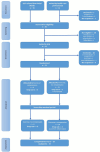Exercise and cancer-related lymphedema in the lower limbs-a randomized cross-over trial on high-intensity interval training (HIIT) with and without compression garments
- PMID: 40240614
- PMCID: PMC12003536
- DOI: 10.1007/s00520-025-09458-x
Exercise and cancer-related lymphedema in the lower limbs-a randomized cross-over trial on high-intensity interval training (HIIT) with and without compression garments
Abstract
Purpose: The aim was to evaluate the safety and possibility of performing high-intensity interval training (HIIT) on a stationary bike for participants with cancer-related lower limb lymphedema (LLL) with and without compression garments in a cross-over design.
Methods: Twenty-one participants with LLL were randomized to two sessions of HIIT on a stationary bike, one with and one without compression garments. The sessions were separated by a seven-day washout period. The trial was carried out in a hospital setting from September to November 2018. The acceptability and safety of the intervention were assessed. The safety was evaluated as adverse events and immediate and 24-h changes in self-reported symptoms (pain, heaviness, and tension). Additionally, recruitment, completion rate, and post-exercise changes in LLL were assessed by circumferential measurements of the legs, dual energy X-ray absorptiometry (DXA), and bioimpedance spectroscopy (BIS), respectively.
Results: Twenty-one out of 35 (60%) eligible patients were included, and 19 (90%) patients completed both exercise sessions. Acceptability was high, and there were no adverse events. There was no clinically relevant difference between performing exercise with and without compression in self-reported symptoms or in limb volume. Small statistically significant differences in soft tissue mass (164.2 g corresponding to 1.4%) and extracellular fluid (L-Dex range < 5 units) were observed with and without compression, respectively, both favoring exercise with compression.
Conclusion: HIIT on a stationary bike was acceptable for patients with LLL and seemed safe regardless of the use of compression garments.
Trial registration: Clinicaltrials.gov registration (NCT03653819).
Keywords: Cancer related lymphedema; Compression; Exercise; High-intensity interval training; Lower limb lymphedema.
© 2025. The Author(s).
Conflict of interest statement
Declarations. Ethical approval: The trial was approved by the Ethical Committee of the Capital Region of Denmark (ID: H- 18031266) and by the Danish Data Protection Agency (I-Suite no.: 06072, ID-no.: HGH- 2017–129) and was conducted in accordance with the Helsinki Declaration. The trial was registered in clinicaltrials.gov (NCT03653819) upon recruitment. Informed consent: Informed consent was obtained from all participants included in the study. Competing interests: The authors declare no competing interests.
Figures
Similar articles
-
EFFECTS OF COMPRESSION ON LYMPHEDEMA DURING RESISTANCE EXERCISE IN WOMEN WITH BREAST CANCER-RELATED LYMPHEDEMA: A RANDOMIZED, CROSS-OVER TRIAL.Lymphology. 2015 Jun;48(2):80-92. Lymphology. 2015. PMID: 26714372 Clinical Trial.
-
Immediate effects of active exercise with compression therapy on lower-limb lymphedema.Support Care Cancer. 2017 Aug;25(8):2603-2610. doi: 10.1007/s00520-017-3671-2. Epub 2017 Apr 6. Support Care Cancer. 2017. PMID: 28386788 Free PMC article. Clinical Trial.
-
Aquatic Exercise Training Outcomes on Functional Capacity, Quality of Life, and Lower Limb Lymphedema: Pilot Study.J Altern Complement Med. 2018 Sep/Oct;24(9-10):1007-1009. doi: 10.1089/acm.2018.0041. J Altern Complement Med. 2018. PMID: 30247973
-
The effect of exercise in patients with lower limb lymphedema: a systematic review.Acta Oncol. 2025 Mar 31;64:484-498. doi: 10.2340/1651-226X.2025.42560. Acta Oncol. 2025. PMID: 40165003 Free PMC article.
-
Water-based exercise for upper and lower limb lymphedema treatment.J Vasc Surg Venous Lymphat Disord. 2023 Jan;11(1):201-209. doi: 10.1016/j.jvsv.2022.08.002. Epub 2022 Aug 20. J Vasc Surg Venous Lymphat Disord. 2023. PMID: 35995327 Review.
References
-
- Best practice for the management of lymphoedema (2006) International consensus. MEP Ltd, London
-
- Cormier JN, Askew RL, Mungovan KS, Xing Y, Ross MI, Armer JM (2010) Lymphedema beyond breast cancer: a systematic review and meta-analysis of cancer-related secondary lymphedema. Cancer 116(22):5138–5149 - PubMed
-
- DiSipio T, Rye S, Newman B, Hayes S (2013) Incidence of unilateral arm lymphoedema after breast cancer: a systematic review and meta-analysis. Lancet Oncol 14(6):500–515 - PubMed
-
- Burian EA, Karlsmark T, Franks PJ, Keeley V, Quéré I, Moffatt CJ (2021) Cellulitis in chronic oedema of the lower leg: an international cross-sectional study. Br J Dermatol 185(1):110–118 - PubMed
-
- Dunberger G, Lindquist H, Waldenström AC, Nyberg T, Steineck G, Åvall-Lundqvist E (2013) Lower limb lymphedema in gynecological cancer survivors–effect on daily life functioning. Support Care Cancer 21(11):3063–3070 - PubMed
Publication types
MeSH terms
Associated data
LinkOut - more resources
Full Text Sources
Medical
Miscellaneous



